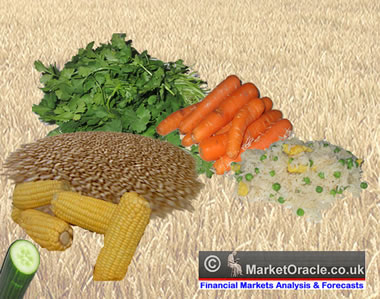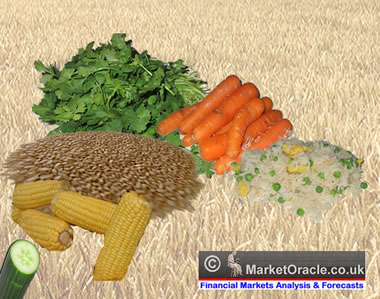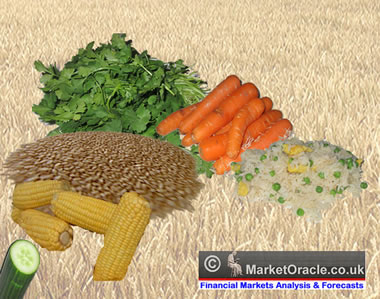Profit from Rising Food Prices with MOO and DBA ETFs
Commodities / Agricultural Commodities Oct 21, 2010 - 08:32 AM GMTBy: Ron_Rowland
 Here’s a question for you … and I’m pretty sure your answer is “Yes.” The question is: Do you eat?
Here’s a question for you … and I’m pretty sure your answer is “Yes.” The question is: Do you eat?
Food is a basic necessity of life. We all need to eat. Some of us eat more than others do, of course. Sadly, some people live in places where there simply isn’t enough food to go around.
The good news is that this is starting to change. The world is going through an agricultural revolution. For ETF investors, it is a potentially huge opening. Today I will tell you how to munch your way to profits.
Three Trends in Food
Three big trends are converging to bring about a dramatic shift in what and how people eat around the world.
|
First, modern technology is opening up new frontiers in food production. Genetically-engineered seed, sophisticated fertilizers, and massive water projects allow farmers to harvest more from every acre … and let them produce from land that was once unusable.
Second, people in the “Emerging Market” nations of China, Brazil, India and many others are changing their diets along with their economies. Millions are finding they can afford things that used to be occasional luxuries: Meat, milk, and even sugar.
Third, Americans are changing their diets, too. Obesity is a national problem — and is hitting the pocketbook in the form of higher health care costs. We aren’t all going on the South Beach Diet. Nevertheless, our eating habits are changing, slowly but surely.
All these developments are causing massive change in the global food production industry. Smart investors know that change brings opportunity as well as risk. And now you can exploit the new trends with ETFs.
If you’ve seen my ETF Field Guide, you know that commodity-related ETFs are a growing niche. I don’t have space to tell you about all these funds, so I’m going to highlight just two of them.
MOO: An ETF You Can Taste
Modern-day agriculture is about big corporations as well as small family farms. Most of the dominant companies are publicly traded … which means you can buy into their success.
|
Agriculture crosses many sectors. Because it is food related, it usually ends up as part of the “Consumer Staples” sector. However, agriculture is so broad that some of the stocks can be found in “Materials,” “Industrials,” and even “Natural Resource” funds. Unfortunately, since these funds are usually capitalization-weighted, the agriculture allocation can be dwarfed by the big multinational energy, mining, chemical, and manufacturing companies.
If your goal is to gain exposure to the food business, you are much better off with an ETF such as Market Vectors Agribusiness (MOO). Some of the top holdings in MOO are familiar names:
- Tractor manufacturer John Deere (DE)
- Fertilizer maker Mosaic (MOS)
- Agribusiness conglomerate Archer Daniels Midland (ADM)
Because MOO includes more than just U.S. stocks, it is also a great way to get a piece of some key foreign companies from this sector. You may not know much about Wilmar International or Yara, but they are big players in this sector.
Right now MOO is tearing higher. From July 1, 2010 through October 20, the shares have climbed more than 37 percent. Some of the gain is related to a falling U.S. Dollar, but the underlying trend in agriculture is also giving MOO a big boost.
One thing you need to understand about MOO: It is a stock ETF. Even though it holds only companies involved in agribusiness, it doesn’t necessarily go up and down along with food commodity prices. If that kind of investment is what you want, you should consider …
DBA: Going Straight to the Source
PowerShares DB Agriculture Fund (DBA) is based on a commodity price index that covers all the major crops: Wheat, corn, sugar, and soybeans as well as some smaller markets like live cattle, lean hogs, coffee and cocoa.
|
I like DBA because it gives you one-stop shopping. Individually, all these markets are subject to wild swings based on weather, export policies and all kinds of other factors. Bundling them together in this way gives you better exposure to the long-term trends.
DBA is also far more convenient (not to mention less risky) than assembling your own portfolio using the futures markets. You don’t have to worry about margin calls, delivery dates, and other minutiae. All that happens behind the scenes in DBA.
What if you put MOO and DBA together? Then you have the agricultural sector covered from both directions. You will participate in the movement of commodity prices as well as changes in the stock price of companies producing those commodities.
DBA has jumped almost 26 percent since its last low in early June, and still has plenty of room for growth on the upside.
MOO and DBA are both good-sized funds with plenty of liquidity on most days. Even so, you will want to use a limit order. Be prepared for plenty of volatility if you choose to buy either of these ETFs. The ride can be rough — but the rewards can be super-sized.
Best wishes,
Ron
This investment news is brought to you by Money and Markets. Money and Markets is a free daily investment newsletter from Martin D. Weiss and Weiss Research analysts offering the latest investing news and financial insights for the stock market, including tips and advice on investing in gold, energy and oil. Dr. Weiss is a leader in the fields of investing, interest rates, financial safety and economic forecasting. To view archives or subscribe, visit http://www.moneyandmarkets.com.
© 2005-2022 http://www.MarketOracle.co.uk - The Market Oracle is a FREE Daily Financial Markets Analysis & Forecasting online publication.






